Budgetary Planning & Control: Zero-Based Budgeting and Performance
VerifiedAdded on 2023/06/18
|13
|3391
|195
Report
AI Summary
This assignment delves into various aspects of budgetary planning and control, contrasting zero-based budgeting with traditional methods and exploring the advantages and disadvantages of activity-based budgeting in a manufacturing context. It addresses the reluctance of managers to participate in budget setting and the potential side effects of top-down budget imposition. The report includes the preparation of an incremental budget, discusses its applicability to different expense types, and compares top-down and bottom-up budgeting approaches. Furthermore, it covers the preparation of a rolling budget and highlights difficulties in changing budgetary systems. The assignment also emphasizes the need for performance measurement, considering both financial and non-financial factors, and provides solutions to address these factors, ultimately aiming to enhance financial performance through improved budgetary practices.
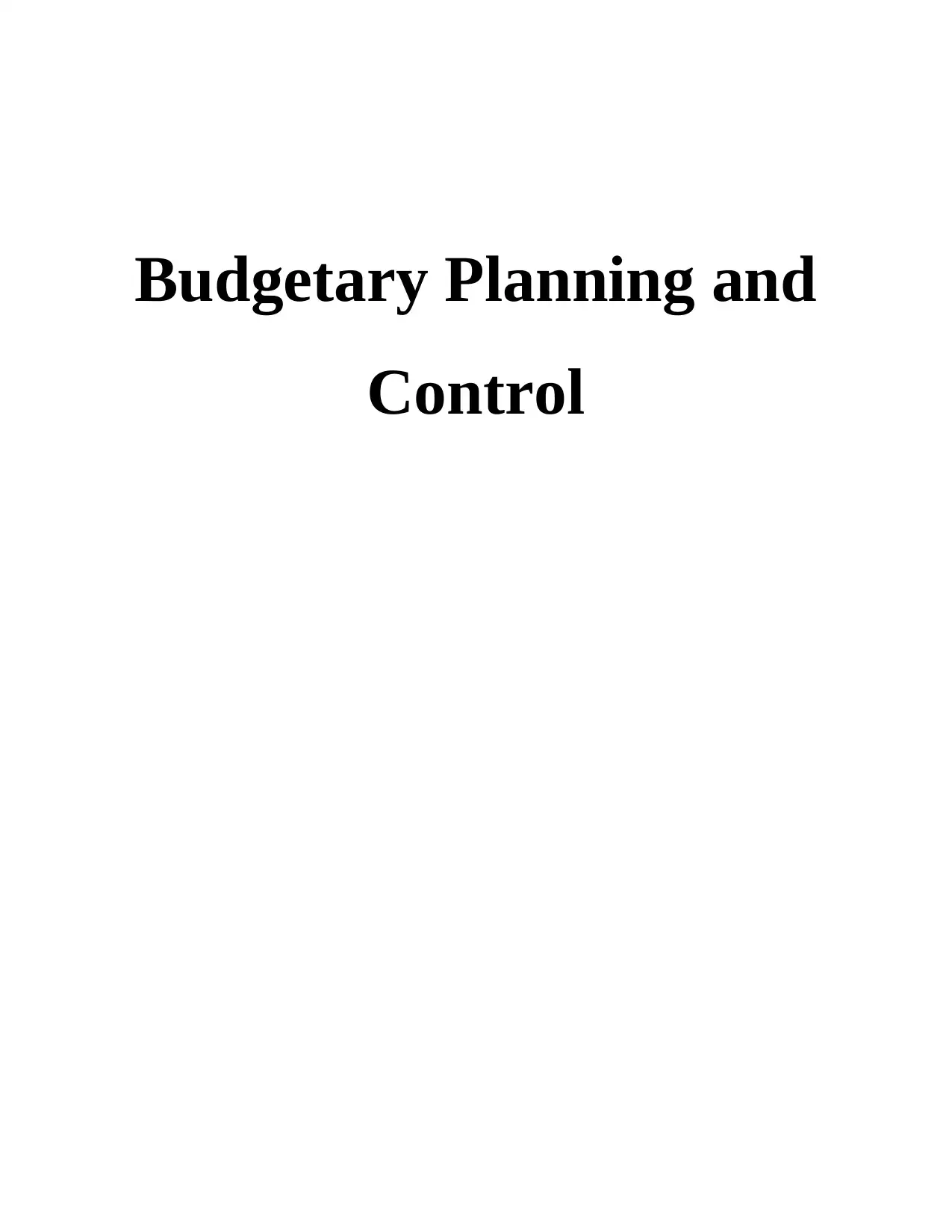
Budgetary Planning and
Control
Control
Paraphrase This Document
Need a fresh take? Get an instant paraphrase of this document with our AI Paraphraser

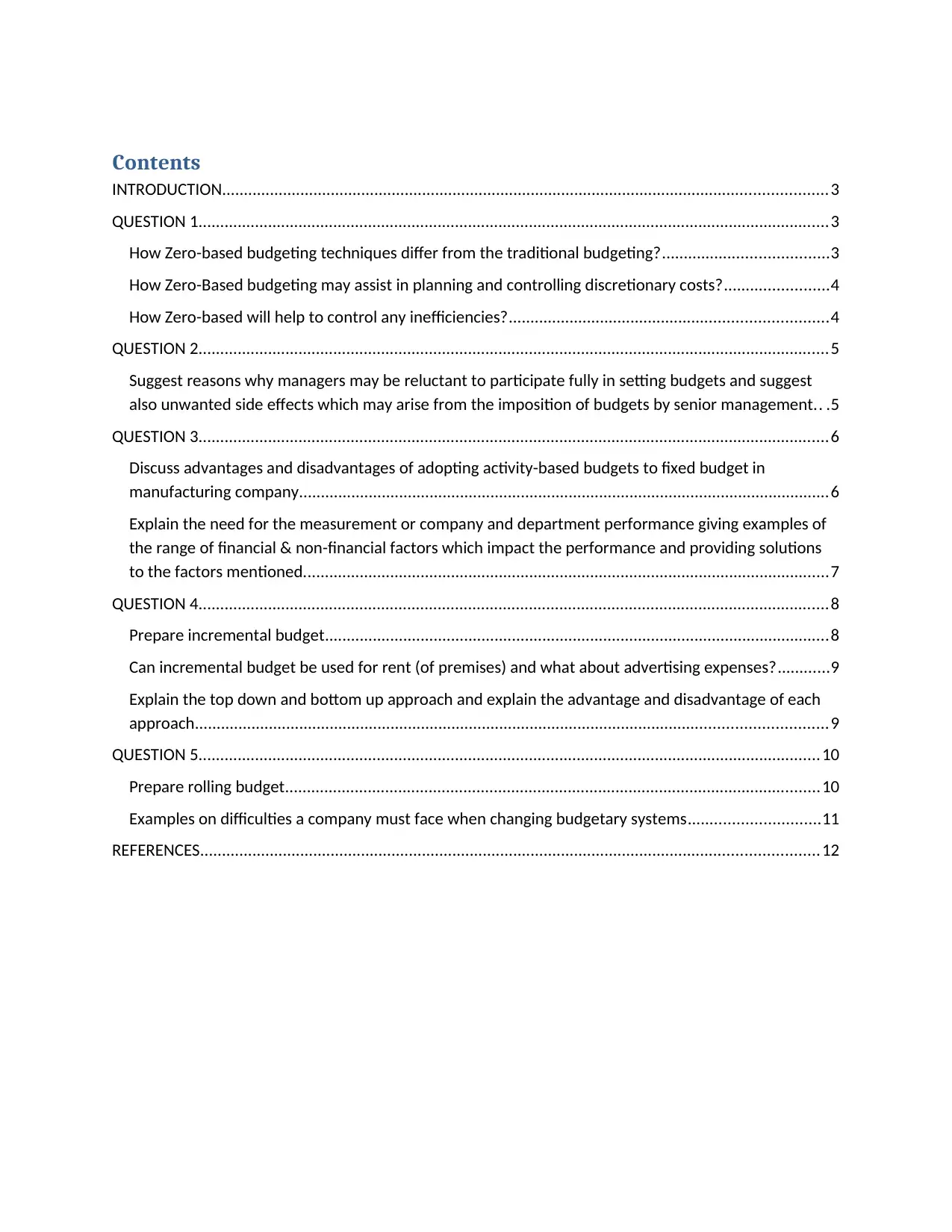
Contents
INTRODUCTION...........................................................................................................................................3
QUESTION 1.................................................................................................................................................3
How Zero-based budgeting techniques differ from the traditional budgeting?......................................3
How Zero-Based budgeting may assist in planning and controlling discretionary costs?........................4
How Zero-based will help to control any inefficiencies?.........................................................................4
QUESTION 2.................................................................................................................................................5
Suggest reasons why managers may be reluctant to participate fully in setting budgets and suggest
also unwanted side effects which may arise from the imposition of budgets by senior management.. .5
QUESTION 3.................................................................................................................................................6
Discuss advantages and disadvantages of adopting activity-based budgets to fixed budget in
manufacturing company..........................................................................................................................6
Explain the need for the measurement or company and department performance giving examples of
the range of financial & non-financial factors which impact the performance and providing solutions
to the factors mentioned.........................................................................................................................7
QUESTION 4.................................................................................................................................................8
Prepare incremental budget....................................................................................................................8
Can incremental budget be used for rent (of premises) and what about advertising expenses?............9
Explain the top down and bottom up approach and explain the advantage and disadvantage of each
approach.................................................................................................................................................9
QUESTION 5...............................................................................................................................................10
Prepare rolling budget...........................................................................................................................10
Examples on difficulties a company must face when changing budgetary systems..............................11
REFERENCES..............................................................................................................................................12
INTRODUCTION...........................................................................................................................................3
QUESTION 1.................................................................................................................................................3
How Zero-based budgeting techniques differ from the traditional budgeting?......................................3
How Zero-Based budgeting may assist in planning and controlling discretionary costs?........................4
How Zero-based will help to control any inefficiencies?.........................................................................4
QUESTION 2.................................................................................................................................................5
Suggest reasons why managers may be reluctant to participate fully in setting budgets and suggest
also unwanted side effects which may arise from the imposition of budgets by senior management.. .5
QUESTION 3.................................................................................................................................................6
Discuss advantages and disadvantages of adopting activity-based budgets to fixed budget in
manufacturing company..........................................................................................................................6
Explain the need for the measurement or company and department performance giving examples of
the range of financial & non-financial factors which impact the performance and providing solutions
to the factors mentioned.........................................................................................................................7
QUESTION 4.................................................................................................................................................8
Prepare incremental budget....................................................................................................................8
Can incremental budget be used for rent (of premises) and what about advertising expenses?............9
Explain the top down and bottom up approach and explain the advantage and disadvantage of each
approach.................................................................................................................................................9
QUESTION 5...............................................................................................................................................10
Prepare rolling budget...........................................................................................................................10
Examples on difficulties a company must face when changing budgetary systems..............................11
REFERENCES..............................................................................................................................................12
⊘ This is a preview!⊘
Do you want full access?
Subscribe today to unlock all pages.

Trusted by 1+ million students worldwide
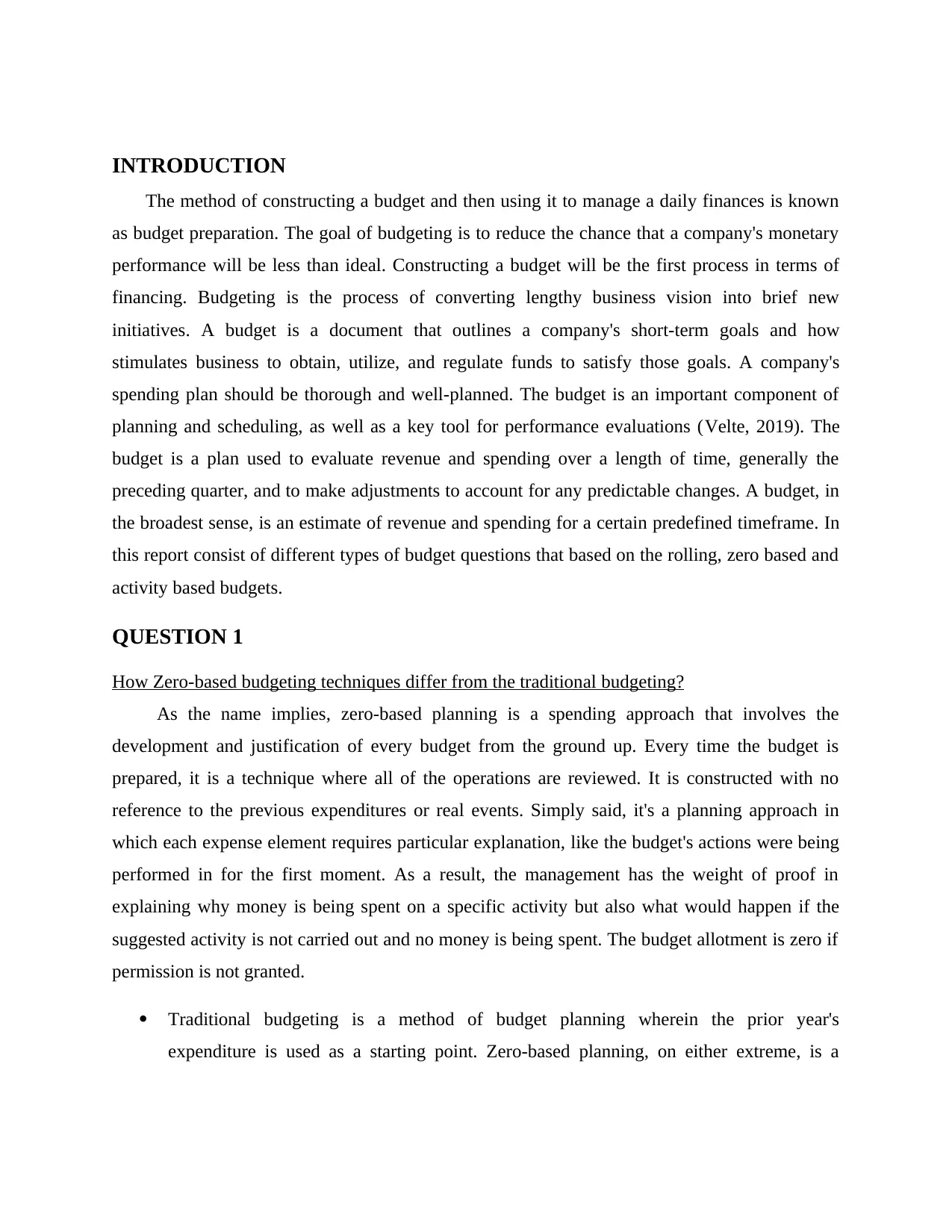
INTRODUCTION
The method of constructing a budget and then using it to manage a daily finances is known
as budget preparation. The goal of budgeting is to reduce the chance that a company's monetary
performance will be less than ideal. Constructing a budget will be the first process in terms of
financing. Budgeting is the process of converting lengthy business vision into brief new
initiatives. A budget is a document that outlines a company's short-term goals and how
stimulates business to obtain, utilize, and regulate funds to satisfy those goals. A company's
spending plan should be thorough and well-planned. The budget is an important component of
planning and scheduling, as well as a key tool for performance evaluations (Velte, 2019). The
budget is a plan used to evaluate revenue and spending over a length of time, generally the
preceding quarter, and to make adjustments to account for any predictable changes. A budget, in
the broadest sense, is an estimate of revenue and spending for a certain predefined timeframe. In
this report consist of different types of budget questions that based on the rolling, zero based and
activity based budgets.
QUESTION 1
How Zero-based budgeting techniques differ from the traditional budgeting?
As the name implies, zero-based planning is a spending approach that involves the
development and justification of every budget from the ground up. Every time the budget is
prepared, it is a technique where all of the operations are reviewed. It is constructed with no
reference to the previous expenditures or real events. Simply said, it's a planning approach in
which each expense element requires particular explanation, like the budget's actions were being
performed in for the first moment. As a result, the management has the weight of proof in
explaining why money is being spent on a specific activity but also what would happen if the
suggested activity is not carried out and no money is being spent. The budget allotment is zero if
permission is not granted.
Traditional budgeting is a method of budget planning wherein the prior year's
expenditure is used as a starting point. Zero-based planning, on either extreme, is a
The method of constructing a budget and then using it to manage a daily finances is known
as budget preparation. The goal of budgeting is to reduce the chance that a company's monetary
performance will be less than ideal. Constructing a budget will be the first process in terms of
financing. Budgeting is the process of converting lengthy business vision into brief new
initiatives. A budget is a document that outlines a company's short-term goals and how
stimulates business to obtain, utilize, and regulate funds to satisfy those goals. A company's
spending plan should be thorough and well-planned. The budget is an important component of
planning and scheduling, as well as a key tool for performance evaluations (Velte, 2019). The
budget is a plan used to evaluate revenue and spending over a length of time, generally the
preceding quarter, and to make adjustments to account for any predictable changes. A budget, in
the broadest sense, is an estimate of revenue and spending for a certain predefined timeframe. In
this report consist of different types of budget questions that based on the rolling, zero based and
activity based budgets.
QUESTION 1
How Zero-based budgeting techniques differ from the traditional budgeting?
As the name implies, zero-based planning is a spending approach that involves the
development and justification of every budget from the ground up. Every time the budget is
prepared, it is a technique where all of the operations are reviewed. It is constructed with no
reference to the previous expenditures or real events. Simply said, it's a planning approach in
which each expense element requires particular explanation, like the budget's actions were being
performed in for the first moment. As a result, the management has the weight of proof in
explaining why money is being spent on a specific activity but also what would happen if the
suggested activity is not carried out and no money is being spent. The budget allotment is zero if
permission is not granted.
Traditional budgeting is a method of budget planning wherein the prior year's
expenditure is used as a starting point. Zero-based planning, on either extreme, is a
Paraphrase This Document
Need a fresh take? Get an instant paraphrase of this document with our AI Paraphraser
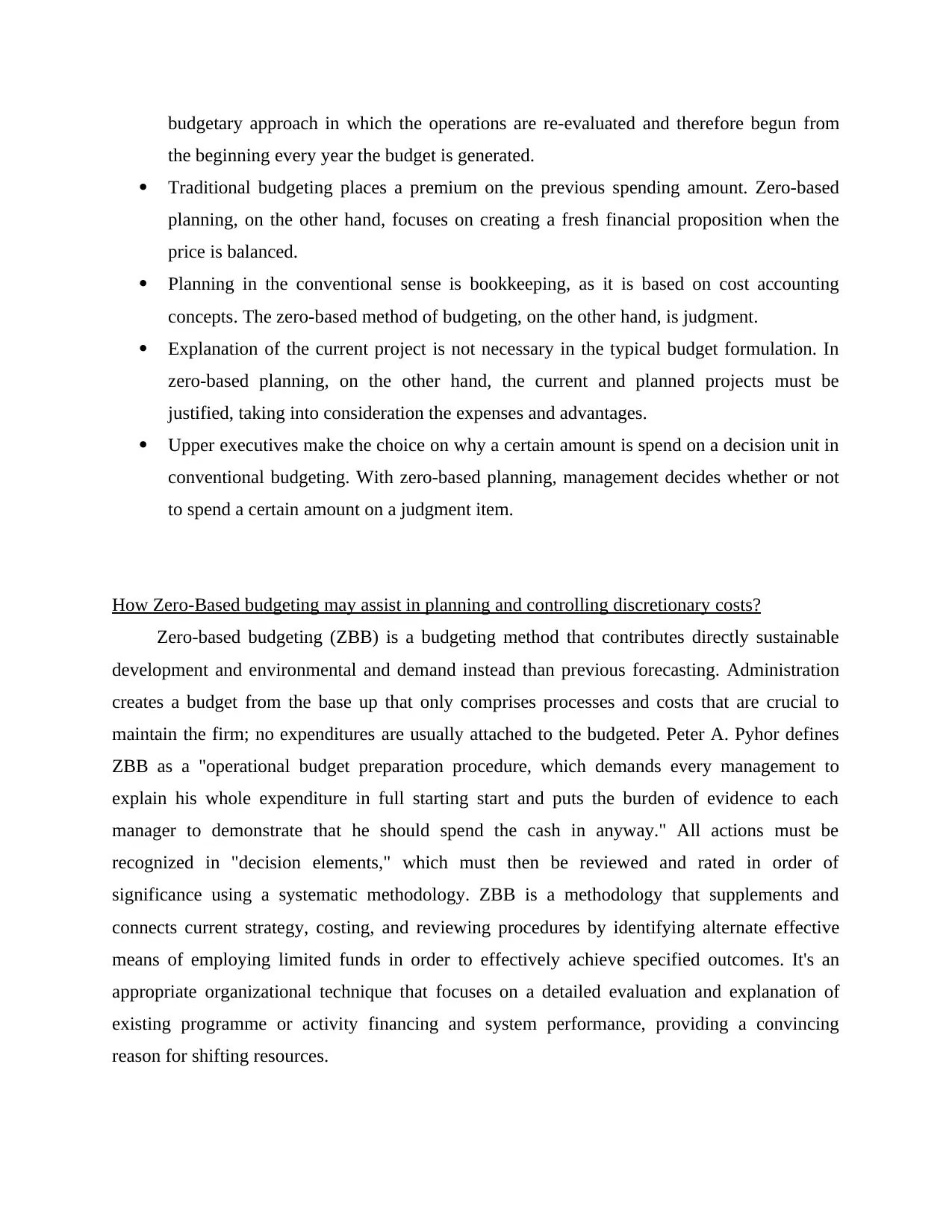
budgetary approach in which the operations are re-evaluated and therefore begun from
the beginning every year the budget is generated.
Traditional budgeting places a premium on the previous spending amount. Zero-based
planning, on the other hand, focuses on creating a fresh financial proposition when the
price is balanced.
Planning in the conventional sense is bookkeeping, as it is based on cost accounting
concepts. The zero-based method of budgeting, on the other hand, is judgment.
Explanation of the current project is not necessary in the typical budget formulation. In
zero-based planning, on the other hand, the current and planned projects must be
justified, taking into consideration the expenses and advantages.
Upper executives make the choice on why a certain amount is spend on a decision unit in
conventional budgeting. With zero-based planning, management decides whether or not
to spend a certain amount on a judgment item.
How Zero-Based budgeting may assist in planning and controlling discretionary costs?
Zero-based budgeting (ZBB) is a budgeting method that contributes directly sustainable
development and environmental and demand instead than previous forecasting. Administration
creates a budget from the base up that only comprises processes and costs that are crucial to
maintain the firm; no expenditures are usually attached to the budgeted. Peter A. Pyhor defines
ZBB as a "operational budget preparation procedure, which demands every management to
explain his whole expenditure in full starting start and puts the burden of evidence to each
manager to demonstrate that he should spend the cash in anyway." All actions must be
recognized in "decision elements," which must then be reviewed and rated in order of
significance using a systematic methodology. ZBB is a methodology that supplements and
connects current strategy, costing, and reviewing procedures by identifying alternate effective
means of employing limited funds in order to effectively achieve specified outcomes. It's an
appropriate organizational technique that focuses on a detailed evaluation and explanation of
existing programme or activity financing and system performance, providing a convincing
reason for shifting resources.
the beginning every year the budget is generated.
Traditional budgeting places a premium on the previous spending amount. Zero-based
planning, on the other hand, focuses on creating a fresh financial proposition when the
price is balanced.
Planning in the conventional sense is bookkeeping, as it is based on cost accounting
concepts. The zero-based method of budgeting, on the other hand, is judgment.
Explanation of the current project is not necessary in the typical budget formulation. In
zero-based planning, on the other hand, the current and planned projects must be
justified, taking into consideration the expenses and advantages.
Upper executives make the choice on why a certain amount is spend on a decision unit in
conventional budgeting. With zero-based planning, management decides whether or not
to spend a certain amount on a judgment item.
How Zero-Based budgeting may assist in planning and controlling discretionary costs?
Zero-based budgeting (ZBB) is a budgeting method that contributes directly sustainable
development and environmental and demand instead than previous forecasting. Administration
creates a budget from the base up that only comprises processes and costs that are crucial to
maintain the firm; no expenditures are usually attached to the budgeted. Peter A. Pyhor defines
ZBB as a "operational budget preparation procedure, which demands every management to
explain his whole expenditure in full starting start and puts the burden of evidence to each
manager to demonstrate that he should spend the cash in anyway." All actions must be
recognized in "decision elements," which must then be reviewed and rated in order of
significance using a systematic methodology. ZBB is a methodology that supplements and
connects current strategy, costing, and reviewing procedures by identifying alternate effective
means of employing limited funds in order to effectively achieve specified outcomes. It's an
appropriate organizational technique that focuses on a detailed evaluation and explanation of
existing programme or activity financing and system performance, providing a convincing
reason for shifting resources.
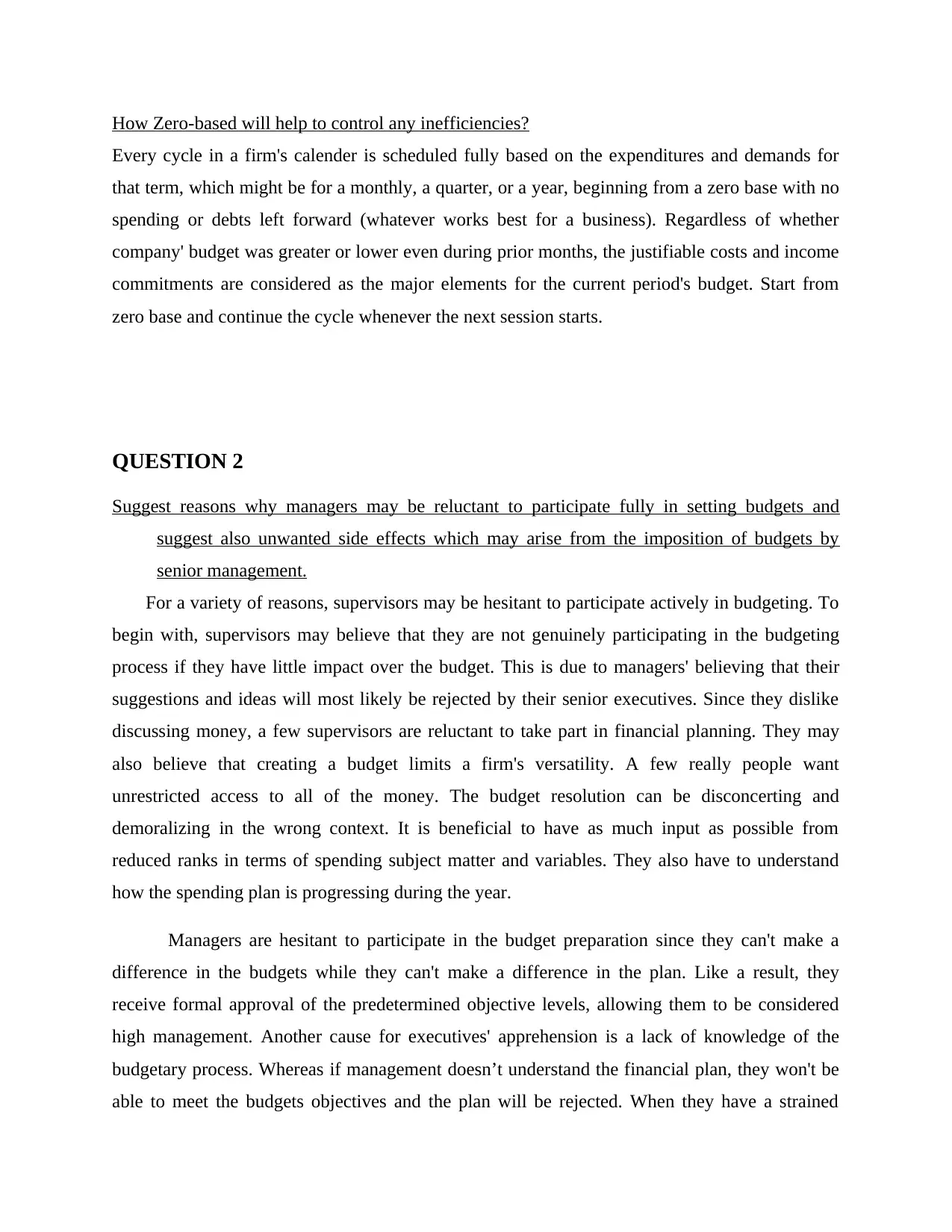
How Zero-based will help to control any inefficiencies?
Every cycle in a firm's calender is scheduled fully based on the expenditures and demands for
that term, which might be for a monthly, a quarter, or a year, beginning from a zero base with no
spending or debts left forward (whatever works best for a business). Regardless of whether
company' budget was greater or lower even during prior months, the justifiable costs and income
commitments are considered as the major elements for the current period's budget. Start from
zero base and continue the cycle whenever the next session starts.
QUESTION 2
Suggest reasons why managers may be reluctant to participate fully in setting budgets and
suggest also unwanted side effects which may arise from the imposition of budgets by
senior management.
For a variety of reasons, supervisors may be hesitant to participate actively in budgeting. To
begin with, supervisors may believe that they are not genuinely participating in the budgeting
process if they have little impact over the budget. This is due to managers' believing that their
suggestions and ideas will most likely be rejected by their senior executives. Since they dislike
discussing money, a few supervisors are reluctant to take part in financial planning. They may
also believe that creating a budget limits a firm's versatility. A few really people want
unrestricted access to all of the money. The budget resolution can be disconcerting and
demoralizing in the wrong context. It is beneficial to have as much input as possible from
reduced ranks in terms of spending subject matter and variables. They also have to understand
how the spending plan is progressing during the year.
Managers are hesitant to participate in the budget preparation since they can't make a
difference in the budgets while they can't make a difference in the plan. Like a result, they
receive formal approval of the predetermined objective levels, allowing them to be considered
high management. Another cause for executives' apprehension is a lack of knowledge of the
budgetary process. Whereas if management doesn’t understand the financial plan, they won't be
able to meet the budgets objectives and the plan will be rejected. When they have a strained
Every cycle in a firm's calender is scheduled fully based on the expenditures and demands for
that term, which might be for a monthly, a quarter, or a year, beginning from a zero base with no
spending or debts left forward (whatever works best for a business). Regardless of whether
company' budget was greater or lower even during prior months, the justifiable costs and income
commitments are considered as the major elements for the current period's budget. Start from
zero base and continue the cycle whenever the next session starts.
QUESTION 2
Suggest reasons why managers may be reluctant to participate fully in setting budgets and
suggest also unwanted side effects which may arise from the imposition of budgets by
senior management.
For a variety of reasons, supervisors may be hesitant to participate actively in budgeting. To
begin with, supervisors may believe that they are not genuinely participating in the budgeting
process if they have little impact over the budget. This is due to managers' believing that their
suggestions and ideas will most likely be rejected by their senior executives. Since they dislike
discussing money, a few supervisors are reluctant to take part in financial planning. They may
also believe that creating a budget limits a firm's versatility. A few really people want
unrestricted access to all of the money. The budget resolution can be disconcerting and
demoralizing in the wrong context. It is beneficial to have as much input as possible from
reduced ranks in terms of spending subject matter and variables. They also have to understand
how the spending plan is progressing during the year.
Managers are hesitant to participate in the budget preparation since they can't make a
difference in the budgets while they can't make a difference in the plan. Like a result, they
receive formal approval of the predetermined objective levels, allowing them to be considered
high management. Another cause for executives' apprehension is a lack of knowledge of the
budgetary process. Whereas if management doesn’t understand the financial plan, they won't be
able to meet the budgets objectives and the plan will be rejected. When they have a strained
⊘ This is a preview!⊘
Do you want full access?
Subscribe today to unlock all pages.

Trusted by 1+ million students worldwide
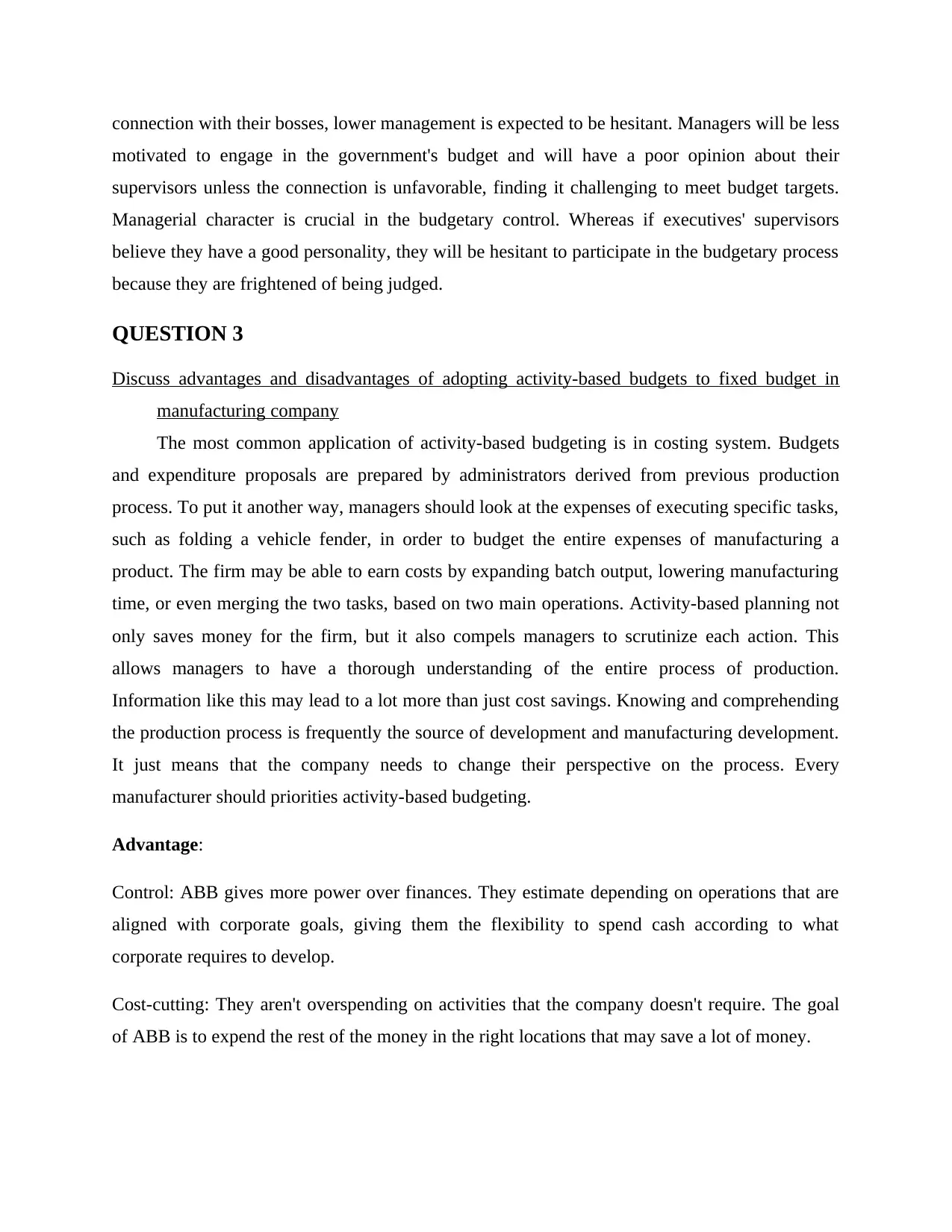
connection with their bosses, lower management is expected to be hesitant. Managers will be less
motivated to engage in the government's budget and will have a poor opinion about their
supervisors unless the connection is unfavorable, finding it challenging to meet budget targets.
Managerial character is crucial in the budgetary control. Whereas if executives' supervisors
believe they have a good personality, they will be hesitant to participate in the budgetary process
because they are frightened of being judged.
QUESTION 3
Discuss advantages and disadvantages of adopting activity-based budgets to fixed budget in
manufacturing company
The most common application of activity-based budgeting is in costing system. Budgets
and expenditure proposals are prepared by administrators derived from previous production
process. To put it another way, managers should look at the expenses of executing specific tasks,
such as folding a vehicle fender, in order to budget the entire expenses of manufacturing a
product. The firm may be able to earn costs by expanding batch output, lowering manufacturing
time, or even merging the two tasks, based on two main operations. Activity-based planning not
only saves money for the firm, but it also compels managers to scrutinize each action. This
allows managers to have a thorough understanding of the entire process of production.
Information like this may lead to a lot more than just cost savings. Knowing and comprehending
the production process is frequently the source of development and manufacturing development.
It just means that the company needs to change their perspective on the process. Every
manufacturer should priorities activity-based budgeting.
Advantage:
Control: ABB gives more power over finances. They estimate depending on operations that are
aligned with corporate goals, giving them the flexibility to spend cash according to what
corporate requires to develop.
Cost-cutting: They aren't overspending on activities that the company doesn't require. The goal
of ABB is to expend the rest of the money in the right locations that may save a lot of money.
motivated to engage in the government's budget and will have a poor opinion about their
supervisors unless the connection is unfavorable, finding it challenging to meet budget targets.
Managerial character is crucial in the budgetary control. Whereas if executives' supervisors
believe they have a good personality, they will be hesitant to participate in the budgetary process
because they are frightened of being judged.
QUESTION 3
Discuss advantages and disadvantages of adopting activity-based budgets to fixed budget in
manufacturing company
The most common application of activity-based budgeting is in costing system. Budgets
and expenditure proposals are prepared by administrators derived from previous production
process. To put it another way, managers should look at the expenses of executing specific tasks,
such as folding a vehicle fender, in order to budget the entire expenses of manufacturing a
product. The firm may be able to earn costs by expanding batch output, lowering manufacturing
time, or even merging the two tasks, based on two main operations. Activity-based planning not
only saves money for the firm, but it also compels managers to scrutinize each action. This
allows managers to have a thorough understanding of the entire process of production.
Information like this may lead to a lot more than just cost savings. Knowing and comprehending
the production process is frequently the source of development and manufacturing development.
It just means that the company needs to change their perspective on the process. Every
manufacturer should priorities activity-based budgeting.
Advantage:
Control: ABB gives more power over finances. They estimate depending on operations that are
aligned with corporate goals, giving them the flexibility to spend cash according to what
corporate requires to develop.
Cost-cutting: They aren't overspending on activities that the company doesn't require. The goal
of ABB is to expend the rest of the money in the right locations that may save a lot of money.
Paraphrase This Document
Need a fresh take? Get an instant paraphrase of this document with our AI Paraphraser
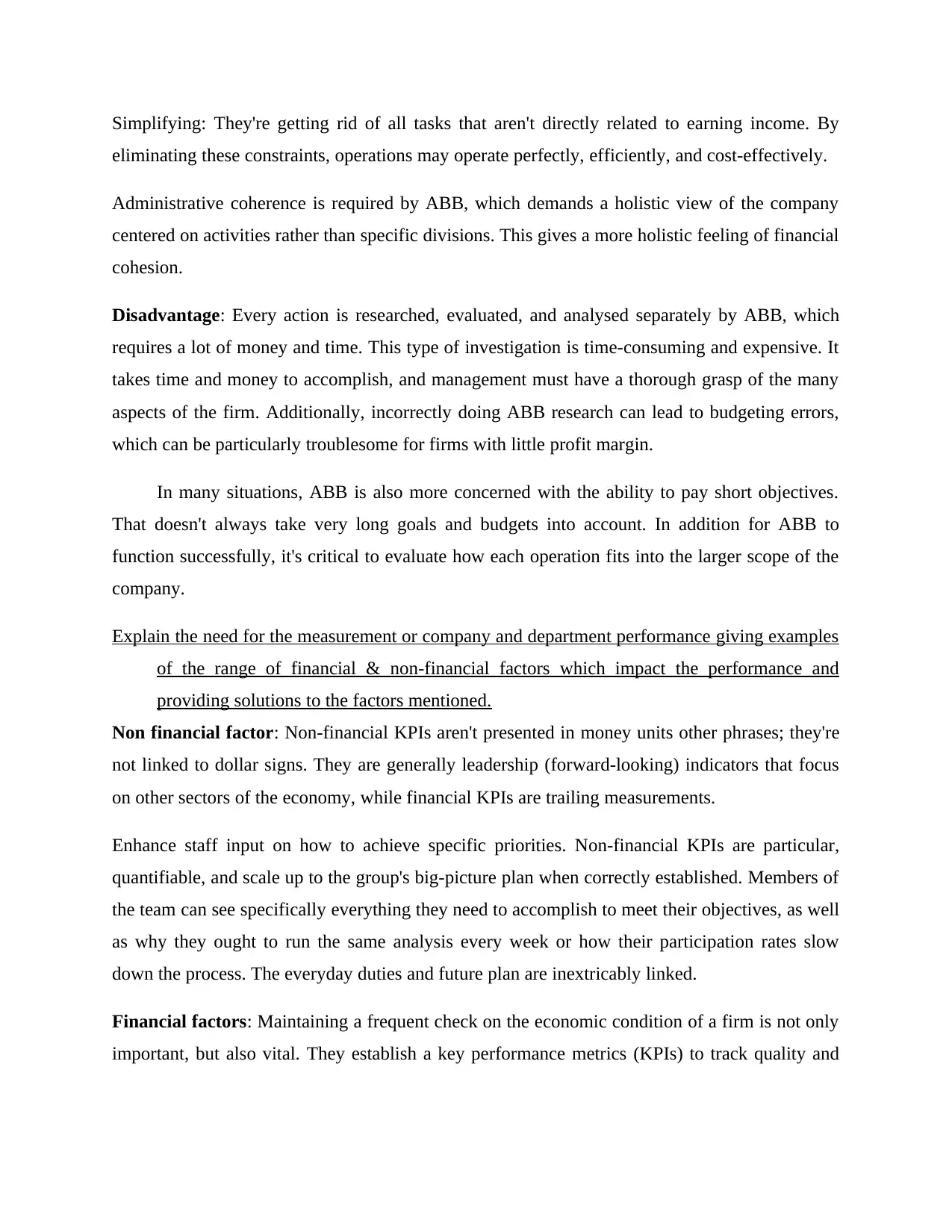
Simplifying: They're getting rid of all tasks that aren't directly related to earning income. By
eliminating these constraints, operations may operate perfectly, efficiently, and cost-effectively.
Administrative coherence is required by ABB, which demands a holistic view of the company
centered on activities rather than specific divisions. This gives a more holistic feeling of financial
cohesion.
Disadvantage: Every action is researched, evaluated, and analysed separately by ABB, which
requires a lot of money and time. This type of investigation is time-consuming and expensive. It
takes time and money to accomplish, and management must have a thorough grasp of the many
aspects of the firm. Additionally, incorrectly doing ABB research can lead to budgeting errors,
which can be particularly troublesome for firms with little profit margin.
In many situations, ABB is also more concerned with the ability to pay short objectives.
That doesn't always take very long goals and budgets into account. In addition for ABB to
function successfully, it's critical to evaluate how each operation fits into the larger scope of the
company.
Explain the need for the measurement or company and department performance giving examples
of the range of financial & non-financial factors which impact the performance and
providing solutions to the factors mentioned.
Non financial factor: Non-financial KPIs aren't presented in money units other phrases; they're
not linked to dollar signs. They are generally leadership (forward-looking) indicators that focus
on other sectors of the economy, while financial KPIs are trailing measurements.
Enhance staff input on how to achieve specific priorities. Non-financial KPIs are particular,
quantifiable, and scale up to the group's big-picture plan when correctly established. Members of
the team can see specifically everything they need to accomplish to meet their objectives, as well
as why they ought to run the same analysis every week or how their participation rates slow
down the process. The everyday duties and future plan are inextricably linked.
Financial factors: Maintaining a frequent check on the economic condition of a firm is not only
important, but also vital. They establish a key performance metrics (KPIs) to track quality and
eliminating these constraints, operations may operate perfectly, efficiently, and cost-effectively.
Administrative coherence is required by ABB, which demands a holistic view of the company
centered on activities rather than specific divisions. This gives a more holistic feeling of financial
cohesion.
Disadvantage: Every action is researched, evaluated, and analysed separately by ABB, which
requires a lot of money and time. This type of investigation is time-consuming and expensive. It
takes time and money to accomplish, and management must have a thorough grasp of the many
aspects of the firm. Additionally, incorrectly doing ABB research can lead to budgeting errors,
which can be particularly troublesome for firms with little profit margin.
In many situations, ABB is also more concerned with the ability to pay short objectives.
That doesn't always take very long goals and budgets into account. In addition for ABB to
function successfully, it's critical to evaluate how each operation fits into the larger scope of the
company.
Explain the need for the measurement or company and department performance giving examples
of the range of financial & non-financial factors which impact the performance and
providing solutions to the factors mentioned.
Non financial factor: Non-financial KPIs aren't presented in money units other phrases; they're
not linked to dollar signs. They are generally leadership (forward-looking) indicators that focus
on other sectors of the economy, while financial KPIs are trailing measurements.
Enhance staff input on how to achieve specific priorities. Non-financial KPIs are particular,
quantifiable, and scale up to the group's big-picture plan when correctly established. Members of
the team can see specifically everything they need to accomplish to meet their objectives, as well
as why they ought to run the same analysis every week or how their participation rates slow
down the process. The everyday duties and future plan are inextricably linked.
Financial factors: Maintaining a frequent check on the economic condition of a firm is not only
important, but also vital. They establish a key performance metrics (KPIs) to track quality and
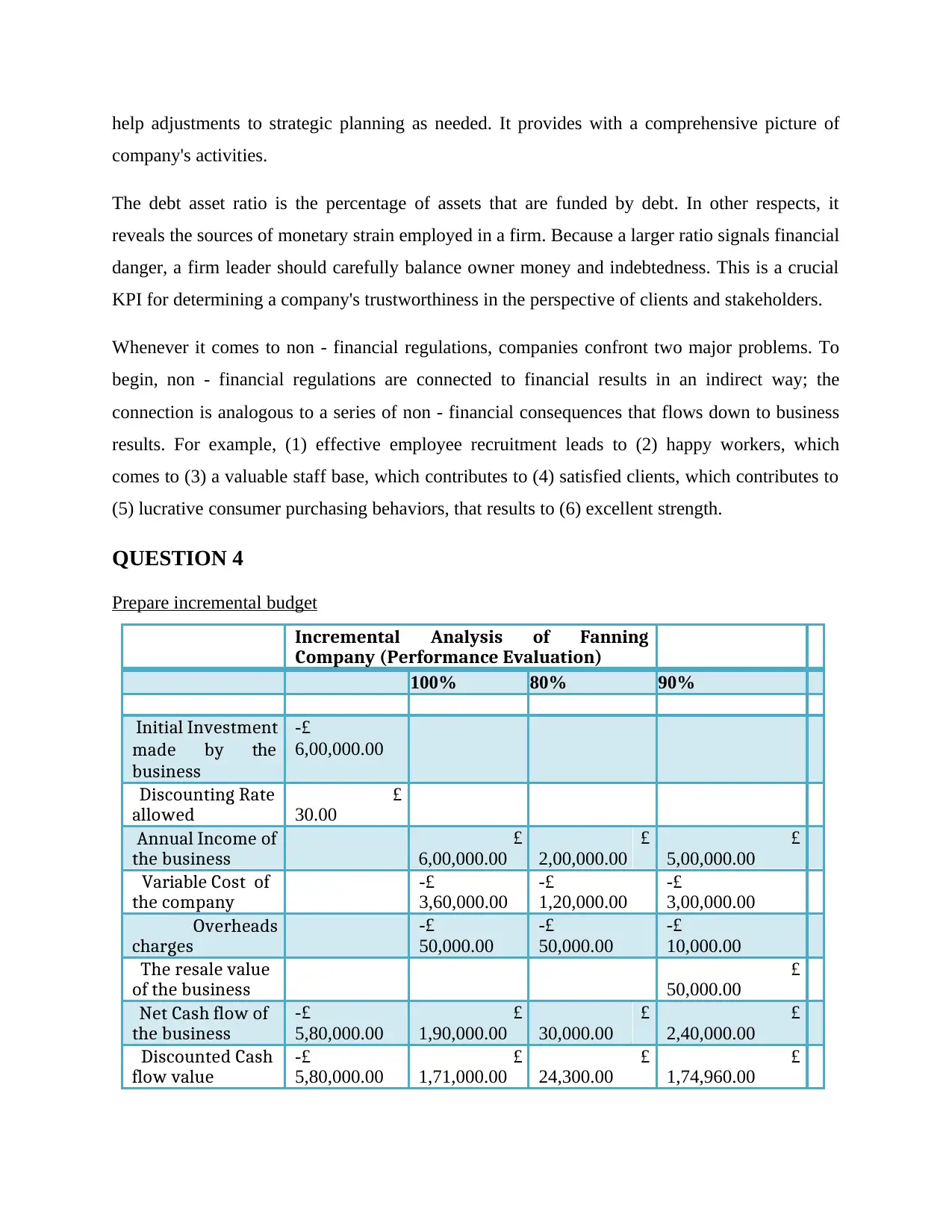
help adjustments to strategic planning as needed. It provides with a comprehensive picture of
company's activities.
The debt asset ratio is the percentage of assets that are funded by debt. In other respects, it
reveals the sources of monetary strain employed in a firm. Because a larger ratio signals financial
danger, a firm leader should carefully balance owner money and indebtedness. This is a crucial
KPI for determining a company's trustworthiness in the perspective of clients and stakeholders.
Whenever it comes to non - financial regulations, companies confront two major problems. To
begin, non - financial regulations are connected to financial results in an indirect way; the
connection is analogous to a series of non - financial consequences that flows down to business
results. For example, (1) effective employee recruitment leads to (2) happy workers, which
comes to (3) a valuable staff base, which contributes to (4) satisfied clients, which contributes to
(5) lucrative consumer purchasing behaviors, that results to (6) excellent strength.
QUESTION 4
Prepare incremental budget
Incremental Analysis of Fanning
Company (Performance Evaluation)
100% 80% 90%
Initial Investment
made by the
business
-£
6,00,000.00
Discounting Rate
allowed 30.00
£
Annual Income of
the business 6,00,000.00
£
2,00,000.00
£
5,00,000.00
£
Variable Cost of
the company
-£
3,60,000.00
-£
1,20,000.00
-£
3,00,000.00
Overheads
charges
-£
50,000.00
-£
50,000.00
-£
10,000.00
The resale value
of the business 50,000.00
£
Net Cash flow of
the business
-£
5,80,000.00 1,90,000.00
£
30,000.00
£
2,40,000.00
£
Discounted Cash
flow value
-£
5,80,000.00 1,71,000.00
£
24,300.00
£
1,74,960.00
£
company's activities.
The debt asset ratio is the percentage of assets that are funded by debt. In other respects, it
reveals the sources of monetary strain employed in a firm. Because a larger ratio signals financial
danger, a firm leader should carefully balance owner money and indebtedness. This is a crucial
KPI for determining a company's trustworthiness in the perspective of clients and stakeholders.
Whenever it comes to non - financial regulations, companies confront two major problems. To
begin, non - financial regulations are connected to financial results in an indirect way; the
connection is analogous to a series of non - financial consequences that flows down to business
results. For example, (1) effective employee recruitment leads to (2) happy workers, which
comes to (3) a valuable staff base, which contributes to (4) satisfied clients, which contributes to
(5) lucrative consumer purchasing behaviors, that results to (6) excellent strength.
QUESTION 4
Prepare incremental budget
Incremental Analysis of Fanning
Company (Performance Evaluation)
100% 80% 90%
Initial Investment
made by the
business
-£
6,00,000.00
Discounting Rate
allowed 30.00
£
Annual Income of
the business 6,00,000.00
£
2,00,000.00
£
5,00,000.00
£
Variable Cost of
the company
-£
3,60,000.00
-£
1,20,000.00
-£
3,00,000.00
Overheads
charges
-£
50,000.00
-£
50,000.00
-£
10,000.00
The resale value
of the business 50,000.00
£
Net Cash flow of
the business
-£
5,80,000.00 1,90,000.00
£
30,000.00
£
2,40,000.00
£
Discounted Cash
flow value
-£
5,80,000.00 1,71,000.00
£
24,300.00
£
1,74,960.00
£
⊘ This is a preview!⊘
Do you want full access?
Subscribe today to unlock all pages.

Trusted by 1+ million students worldwide
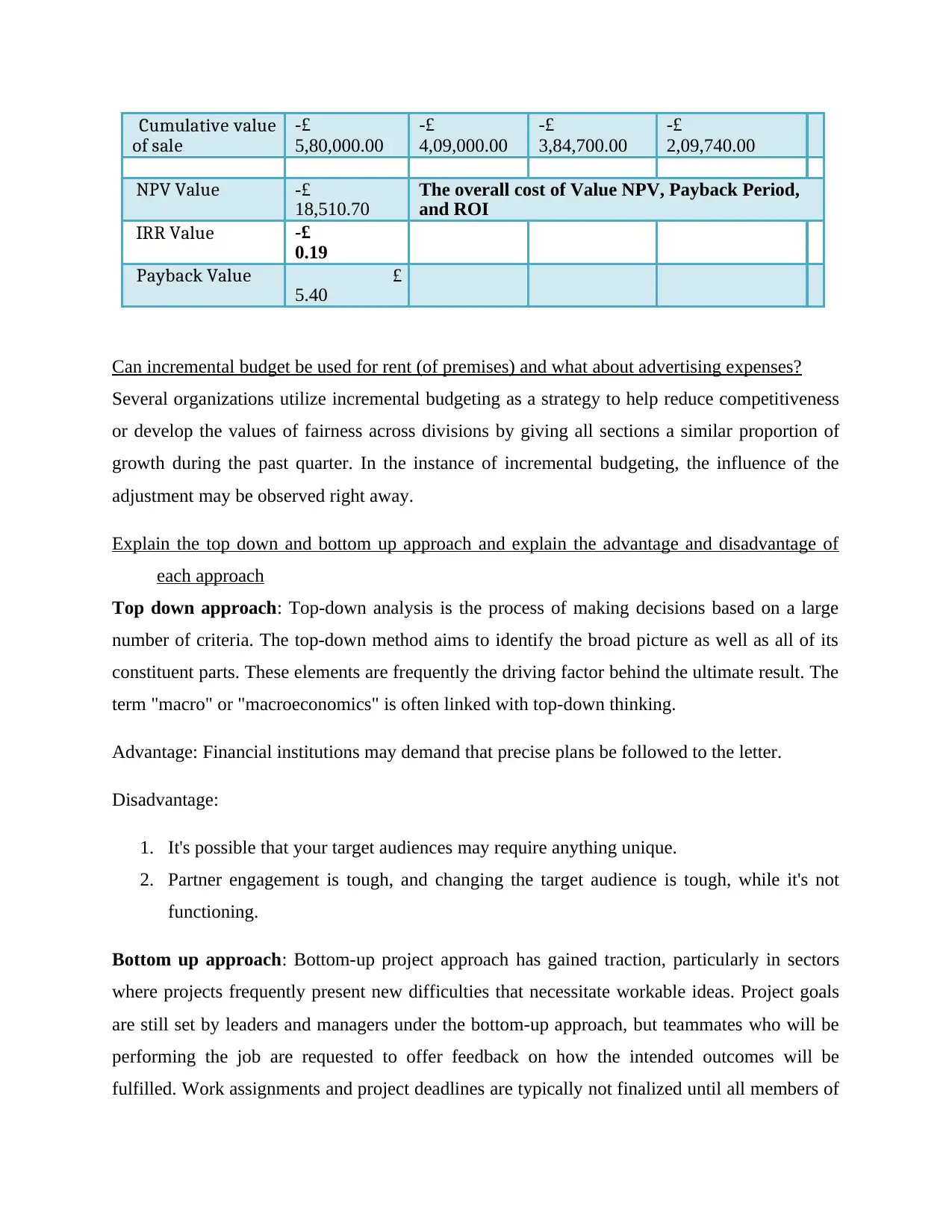
Cumulative value
of sale
-£
5,80,000.00
-£
4,09,000.00
-£
3,84,700.00
-£
2,09,740.00
NPV Value -£
18,510.70
The overall cost of Value NPV, Payback Period,
and ROI
IRR Value -£
0.19
Payback Value
5.40
£
Can incremental budget be used for rent (of premises) and what about advertising expenses?
Several organizations utilize incremental budgeting as a strategy to help reduce competitiveness
or develop the values of fairness across divisions by giving all sections a similar proportion of
growth during the past quarter. In the instance of incremental budgeting, the influence of the
adjustment may be observed right away.
Explain the top down and bottom up approach and explain the advantage and disadvantage of
each approach
Top down approach: Top-down analysis is the process of making decisions based on a large
number of criteria. The top-down method aims to identify the broad picture as well as all of its
constituent parts. These elements are frequently the driving factor behind the ultimate result. The
term "macro" or "macroeconomics" is often linked with top-down thinking.
Advantage: Financial institutions may demand that precise plans be followed to the letter.
Disadvantage:
1. It's possible that your target audiences may require anything unique.
2. Partner engagement is tough, and changing the target audience is tough, while it's not
functioning.
Bottom up approach: Bottom-up project approach has gained traction, particularly in sectors
where projects frequently present new difficulties that necessitate workable ideas. Project goals
are still set by leaders and managers under the bottom-up approach, but teammates who will be
performing the job are requested to offer feedback on how the intended outcomes will be
fulfilled. Work assignments and project deadlines are typically not finalized until all members of
of sale
-£
5,80,000.00
-£
4,09,000.00
-£
3,84,700.00
-£
2,09,740.00
NPV Value -£
18,510.70
The overall cost of Value NPV, Payback Period,
and ROI
IRR Value -£
0.19
Payback Value
5.40
£
Can incremental budget be used for rent (of premises) and what about advertising expenses?
Several organizations utilize incremental budgeting as a strategy to help reduce competitiveness
or develop the values of fairness across divisions by giving all sections a similar proportion of
growth during the past quarter. In the instance of incremental budgeting, the influence of the
adjustment may be observed right away.
Explain the top down and bottom up approach and explain the advantage and disadvantage of
each approach
Top down approach: Top-down analysis is the process of making decisions based on a large
number of criteria. The top-down method aims to identify the broad picture as well as all of its
constituent parts. These elements are frequently the driving factor behind the ultimate result. The
term "macro" or "macroeconomics" is often linked with top-down thinking.
Advantage: Financial institutions may demand that precise plans be followed to the letter.
Disadvantage:
1. It's possible that your target audiences may require anything unique.
2. Partner engagement is tough, and changing the target audience is tough, while it's not
functioning.
Bottom up approach: Bottom-up project approach has gained traction, particularly in sectors
where projects frequently present new difficulties that necessitate workable ideas. Project goals
are still set by leaders and managers under the bottom-up approach, but teammates who will be
performing the job are requested to offer feedback on how the intended outcomes will be
fulfilled. Work assignments and project deadlines are typically not finalized until all members of
Paraphrase This Document
Need a fresh take? Get an instant paraphrase of this document with our AI Paraphraser
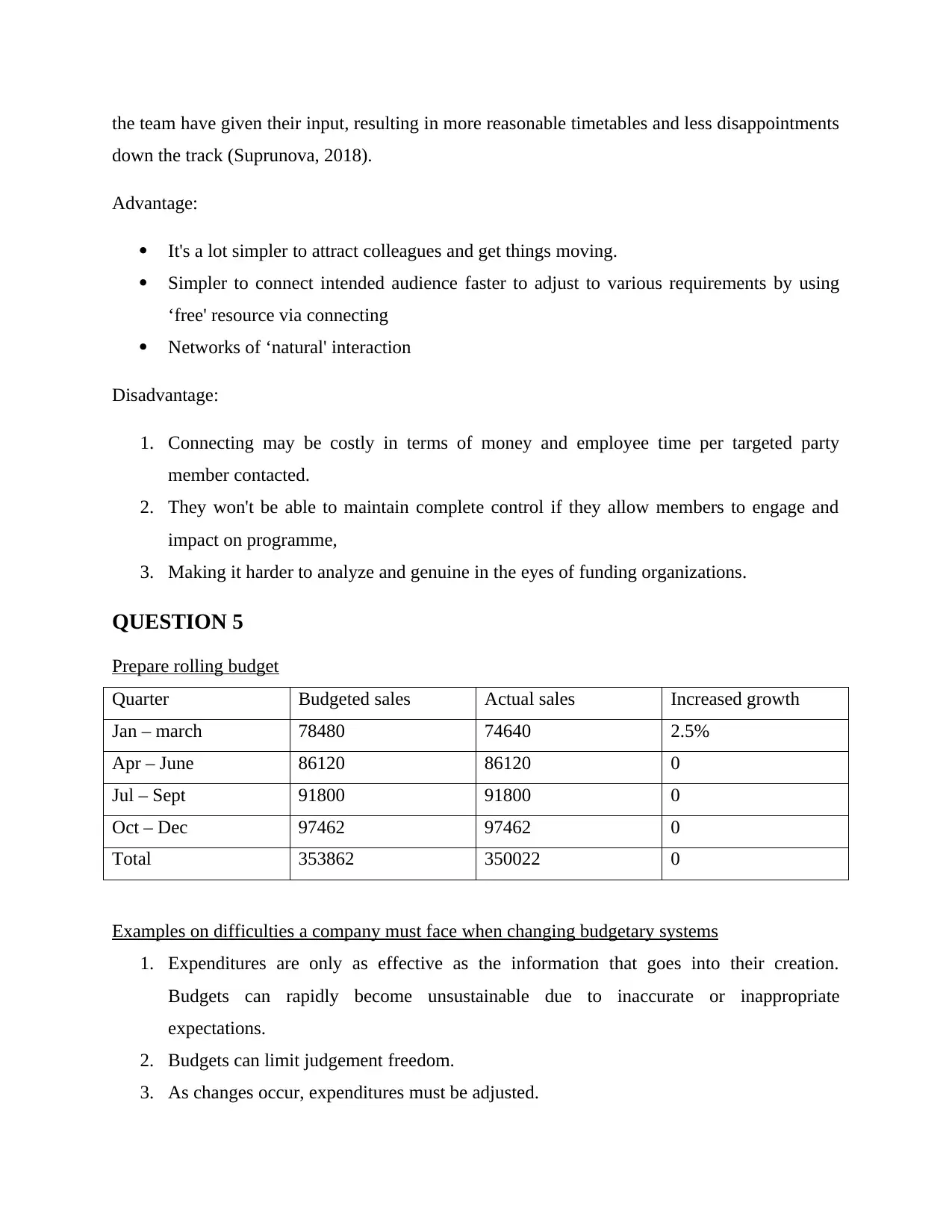
the team have given their input, resulting in more reasonable timetables and less disappointments
down the track (Suprunova, 2018).
Advantage:
It's a lot simpler to attract colleagues and get things moving.
Simpler to connect intended audience faster to adjust to various requirements by using
‘free' resource via connecting
Networks of ‘natural' interaction
Disadvantage:
1. Connecting may be costly in terms of money and employee time per targeted party
member contacted.
2. They won't be able to maintain complete control if they allow members to engage and
impact on programme,
3. Making it harder to analyze and genuine in the eyes of funding organizations.
QUESTION 5
Prepare rolling budget
Quarter Budgeted sales Actual sales Increased growth
Jan – march 78480 74640 2.5%
Apr – June 86120 86120 0
Jul – Sept 91800 91800 0
Oct – Dec 97462 97462 0
Total 353862 350022 0
Examples on difficulties a company must face when changing budgetary systems
1. Expenditures are only as effective as the information that goes into their creation.
Budgets can rapidly become unsustainable due to inaccurate or inappropriate
expectations.
2. Budgets can limit judgement freedom.
3. As changes occur, expenditures must be adjusted.
down the track (Suprunova, 2018).
Advantage:
It's a lot simpler to attract colleagues and get things moving.
Simpler to connect intended audience faster to adjust to various requirements by using
‘free' resource via connecting
Networks of ‘natural' interaction
Disadvantage:
1. Connecting may be costly in terms of money and employee time per targeted party
member contacted.
2. They won't be able to maintain complete control if they allow members to engage and
impact on programme,
3. Making it harder to analyze and genuine in the eyes of funding organizations.
QUESTION 5
Prepare rolling budget
Quarter Budgeted sales Actual sales Increased growth
Jan – march 78480 74640 2.5%
Apr – June 86120 86120 0
Jul – Sept 91800 91800 0
Oct – Dec 97462 97462 0
Total 353862 350022 0
Examples on difficulties a company must face when changing budgetary systems
1. Expenditures are only as effective as the information that goes into their creation.
Budgets can rapidly become unsustainable due to inaccurate or inappropriate
expectations.
2. Budgets can limit judgement freedom.
3. As changes occur, expenditures must be adjusted.

4. Budgeting is a day when procedure; in large corporations, whole divisions may be
devoted to planning and management.
5. Budgets might lead to rash short-term judgments in order to stay inside the cost instead of
making the best long-term option that goes beyond the budget.
6. Managers might become obsessed with creating and evaluating budgets, losing sight of
the actual challenges of gaining consumers (Rajagukguk, 2018).
devoted to planning and management.
5. Budgets might lead to rash short-term judgments in order to stay inside the cost instead of
making the best long-term option that goes beyond the budget.
6. Managers might become obsessed with creating and evaluating budgets, losing sight of
the actual challenges of gaining consumers (Rajagukguk, 2018).
⊘ This is a preview!⊘
Do you want full access?
Subscribe today to unlock all pages.

Trusted by 1+ million students worldwide
1 out of 13
Related Documents
Your All-in-One AI-Powered Toolkit for Academic Success.
+13062052269
info@desklib.com
Available 24*7 on WhatsApp / Email
![[object Object]](/_next/static/media/star-bottom.7253800d.svg)
Unlock your academic potential
Copyright © 2020–2025 A2Z Services. All Rights Reserved. Developed and managed by ZUCOL.





